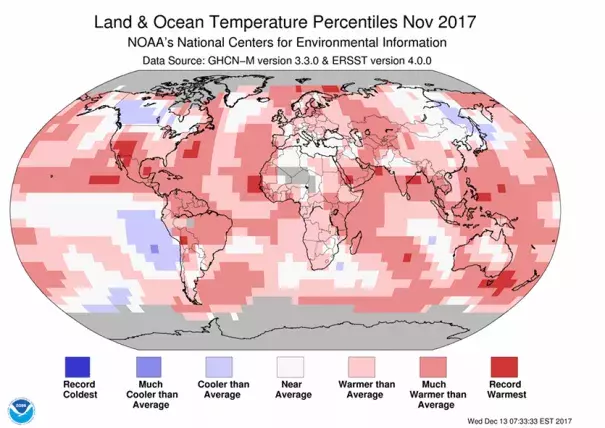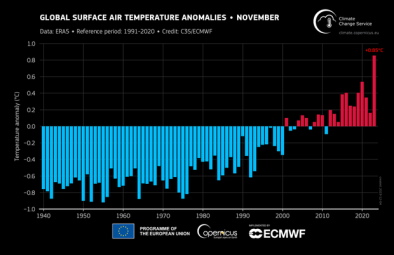November 2017: A Top-Five Warmest November Globally

November 2017 was Earth's fifth warmest November since record keeping began in 1880, said NOAA's National Centers for Environmental Information (NCEI) on Monday. NOAA rated the five warmest Novembers since 1880 as being 2015, 2013, 2010, 2004, and 2017 (tied with 2016.) NASA rated November 2017 as the planet’s third warmest November on record, with the only warmer Novembers coming in 2015 and 2016. Minor differences can occur between the NASA and NOAA rankings because of their different techniques for analyzing data-sparse regions such as the Arctic.
Global ocean temperatures last month were the fourth warmest on record for any November, according to NOAA, and global land temperatures were the ninth warmest on record. Global satellite-measured temperatures for the lowest 8 km of the atmosphere were the second or third warmest for any November in the 39-year record, according to the University of Alabama Huntsville (UAH) and Remote Sensing Systems (RSS), respectively.
Third-warmest year on record thus far
Each of the first eleven months of 2017 have ranked among the top five warmest such months on record, giving 2017 the third highest January–November temperature in the 138-year record: 0.84°C (1.51°F) above the 20th-century average. This is behind the record year of 2016 by 0.12°C (0.22°F), and behind the second-place year of 2015 by 0.03°C (0.05°F). The near-record warmth in 2017 is especially remarkable given the lack of an El Niño event this year. Global temperatures tend to be warmer during El Niño years, when the ocean releases more heat to the atmosphere. This year is almost certain to be the planet's warmest year on record that lacks any influence from El Niño, and will likely be the second or third warmest year in recorded history. Earth's four warmest years of the last century-plus are virtually certain to be the four years from 2014 through 2017.
Related Content






